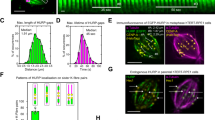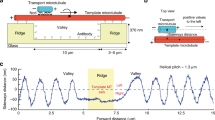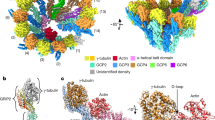Abstract
During prometaphase in mitotic cell division, chromosomes attach to the walls of microtubules and subsequently move to microtubule ends, where they stay throughout mitosis1,2. This end-attachment seems to be essential for correct chromosome segregating. However, the mechanism by which kinetochores, the multiprotein complexes that link chromosomes to the microtubules of the mitotic spindle3,4, recognize and stay attached to microtubule ends is not understood. One clue comes from the hydrolysis of GTP that occurs during microtubule polymerization. Although tubulin dimers must contain GTP to polymerize, this GTP is rapidly hydrolysed following the addition of dimers to a growing polymer. This creates a microtubule consisting largely of GDP-tubulin, with a small cap of GTP-tubulin at the end5. It is possible that kinetochores distinguish the different structural states of a GTP- versus a GDP-microtubule lattice. We have examined this question in vitro using reconstituted kinetochores from the yeast Saccharomyces cerevisiae. We found that kinetochores in vitro bind preferentially to GTP- rather than GDP-microtubules, and to the plus-end preferentially over the lattice. Our results could explain how kinetochores stay at microtubule ends and thus segregate chromosomes correctly during mitosis invivo. This result demonstrates that proteins exist that can distinguish the GTP conformation of the microtubule lattice.
This is a preview of subscription content, access via your institution
Access options
Subscribe to this journal
Receive 51 print issues and online access
$199.00 per year
only $3.90 per issue
Buy this article
- Purchase on Springer Link
- Instant access to full article PDF
Prices may be subject to local taxes which are calculated during checkout




Similar content being viewed by others
References
Rieder, C. L. & Alexander, S. P. Kinetochores are transported poleward along a single astral microtubule during chromosome attachment to the spindle in newt lung cells. J. Cell Biol. 110, 81–95 (1990).
Skibbens, R. V., Skeen, V. P. & Salmon, E. D. Directional instability of kinetochore motility during chromosome congression and segregation in mitotic newt lung cells: A push–pull mechanism. J. Cell. Biol. 122, 859–875 (1993).
Earnshaw, W. C. & Tomkiel, J. E. Centromere and kinetomore structure. Curr. Biol. 4, 86–93 (1992).
Bloom, K. The centromere frontier: kinetochore components, microtubule-based motility, and the CEN-value paradox. Cell 73, 621–624 (1993).
Kirschner, M. W. & Mitchison, T. J. Beyond self assembly: from microtubules to morphogenesis. Cell 45, 329–342 (1986).
Schilstra, M. J., Martin, S. R. & Bayley, P. M. On the relationship between nucleotide hydrolysis and microtubule assembly: studies with a GTP-regenerating system. Biochem. Biophys. Res. Comm. 147, 588–595 (1987).
O'Brien, E. T., Voter, W. A. & Erickson, H. P. GTP hydrolysis during microtubule assembly. Biochemistry 26, 4148–4156 (1987).
Stewart, R. J., Farrel, K. W. & Wilson, L. Role of GTP hydrolysis in microtubule polymerisation: evidence for a coupled hydrolysis mechanism. Biochemistry 29, 6489–6498 (1990).
Hyman, A. A., Salser, S., Drechsel, D. N., Unwin, N. & Mitchison, T. J. Role of GTP hydrolysis in microtubule dynamics: information from a slowly hydrolyzable analogue, GMPCPP. Mol. Biol. Cell. 3, 1155–1167 (1992).
Sorger, P. K., Severin, F. F. & Hyman, A. A. Factors required for the binding of reassembled yeast kinetochores to microtubules in vitro. J. Cell. Biol. 127, 995–1008 (1994).
Bailey, N. Statistical methods in Biology(Cambridge Univ. Press, (1995)).
Hyman, A. A., Chretien, D., Arnal, I. & Wade, R. H. Structural changes accompanying GTP hydrolysis in microtubules: information from a slowly hydrolyzable analogue guanylyl-(α, β)-methylene-diphosphonate. J. Cell Biol. 128, 117–125 (1995).
Arnal, I. & Wade, R. H. How does taxol stabilize microtubules? Curr. Biol. 5, 900–908 (1995).
McIntosh, J. R. & Euteneuer, U. Tubulin hooks as probes for microtubule polarity: an analysis of the method and an evaluation of data on microtubule polarity in the mitotic spindle. J. Cell Biol. 98, 525–533 (1984).
Kingsbury, J. & Koshland, D. Centromere-dependent binding of yeast minichromosomes to microtubules in vitro. Cell 66, 483–495 (1991).
Mitchison, T. J. & Kirschner, T. J. Dynamic instability of microtubule growth. Nature 312, 237–242 (1984).
Lechner, J. & Carbon, J. A240 kd multisubunit protein complex, CBF3, is a major component of the budding yeast centromere. Cell 64, 717–726 (1991).
Jiang, W., Lechner, J. & Carbon, J. Isolation and characterization of a gene (CBF2) specifying a protein component of the budding yeast centromere. J. Cell Biol. 121, 513–519 (1993).
Strunnikov, A. V., Kingsbury, J. & Koshland, D. CEP3 encodes a centromere protein of Saccharomyces cerevisiae. J. Cell Biol. 128, 749–760 (1995).
Connely, C. & Heiter, P. Budding yeast SKP1 encodes an evolutionary conserved protein required for cell cycle progression. Cell 86, 275–285 (1996).
Kingbury, J. & Koshland, D. Centromere function on minichromosomes isolated from budding yeast. Mol. Biol. Cell 4, 859–870 (1993).
Miller, J. M., Wang, W., Balczon, R. & Dentler, W. L. Ciliary microtubule capping structures contain a mammalian kinetochore antigen. J. Cell. Biol. 110, 703–714 (1990).
Wang, W., Suprenant, K. & Dentler, W. Reversible association of a 97-kDa protein complex found at the tips of ciliary microtubules with in vitro assembled microtubules. J. Biol. Chem. 268, 24796–24807 (1993).
Mitchison, T., Evans, L., Schulze, E. & Kirschner, M. Sites of microtubule assembly and disassembly in the mitotic spindle. Cell 45, 515–527 (1986).
Hyman, A. A. & Mitchison, T. J. Two different microtubule-based motor activities with opposite polarities in kinetochores. Nature 351, 206–211 (1991).
Cassimeris, L., Pryer, N. K. & Salmon, E. D. Real-time observations of microtubule dynamic instability in living cells. J. Cell Biol. 107, 2223–2231 (1988).
Walker, R. A.et al. Dynamic instability of individual microtubules analysed by video light microscopy: rate constants and transition frequencies. J. Cell Biol. 107, 1437–1448 (1988).
Belmont, L. D., Hyman, A. A., Sawin, K. E. & Mitchison, T. J. Real-time visualization of cell cycle-dependent changes in microtubule dynamics in cytoplasmic extracts. Cell 62, 579–589 (1990).
Sammak, P. J. & Borisy, G. G. Direct observation of microtubule dynamics in living cells. Nature 332, 724–726 (1988).
Hyman, A. A.et al. Preparation of modified tubulins. Methods Enzymol. 196, 478–485 (1991).
Huitorel, P. & Kirschner, M. W. The polarity and stability of microtubule capture by the kinetochore. J.Cell. Biol. 106, 151–160 (1988).
Acknowledgements
We thank S. Schuyler for early experiments suggesting the role of lattice structure; J.Howard for help with statistics; and M. Glotzer, P. Gonczy, S. Eaton, K. Simons, R. Heald, S. Reinsch and S. Andersen for critical reading of the manuscript.
Author information
Authors and Affiliations
Rights and permissions
About this article
Cite this article
Severin, F., Sorger, P. & Hyman, A. Kinetochores distinguish GTP from GDP forms of the microtubule lattice. Nature 388, 888–891 (1997). https://doi.org/10.1038/42270
Received:
Accepted:
Issue Date:
DOI: https://doi.org/10.1038/42270
This article is cited by
-
The life and miracles of kinetochores
The EMBO Journal (2009)
-
On and Around Microtubules: An Overview
Molecular Biotechnology (2009)
-
Structural rearrangements in tubulin following microtubule formation
EMBO reports (2005)
-
Rings around kinetochore microtubules in yeast
Nature Structural & Molecular Biology (2005)
-
Control of microtubule dynamics by the antagonistic activities of XMAP215 and XKCM1 in Xenopus egg extracts
Nature Cell Biology (2000)
Comments
By submitting a comment you agree to abide by our Terms and Community Guidelines. If you find something abusive or that does not comply with our terms or guidelines please flag it as inappropriate.



